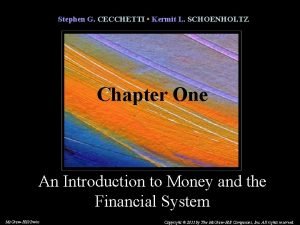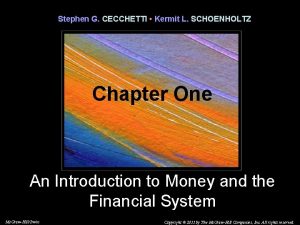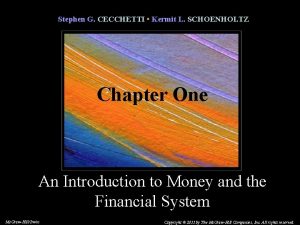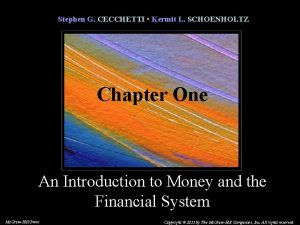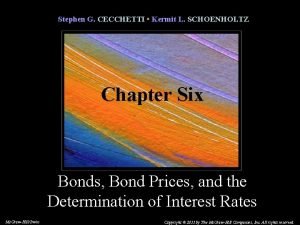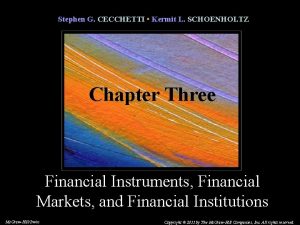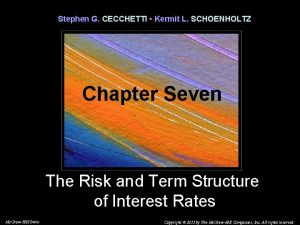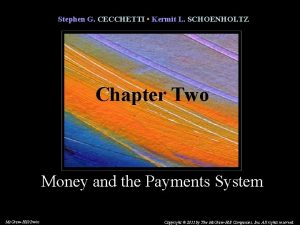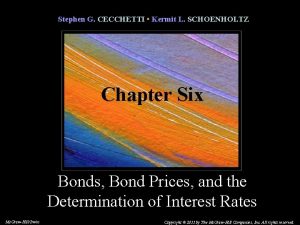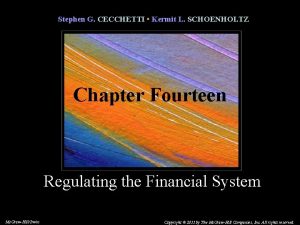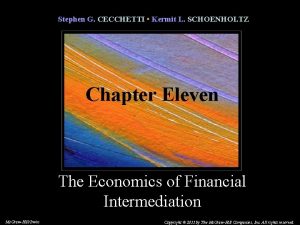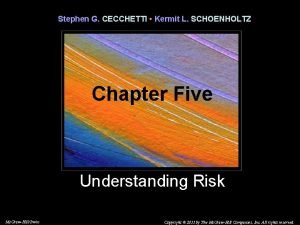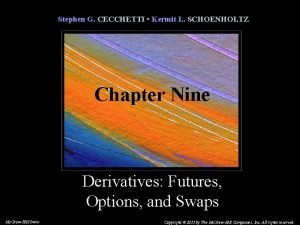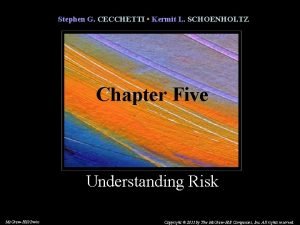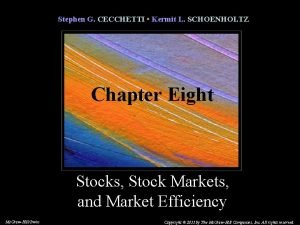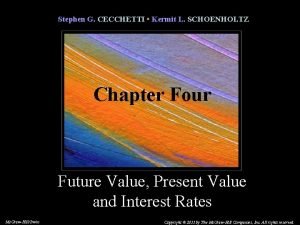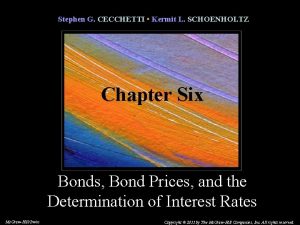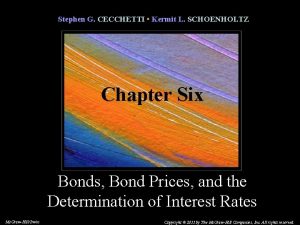Stephen G CECCHETTI Kermit L SCHOENHOLTZ Chapter One





















- Slides: 21

Stephen G. CECCHETTI • Kermit L. SCHOENHOLTZ Chapter One An Introduction to Money and the Financial System Mc. Graw-Hill/Irwin Copyright © 2011 by The Mc. Graw-Hill Companies, Inc. All rights reserved.

Introduction • Every financial transaction has a story. • There is a complex web of interdependent institutions and markets making up the foundation of daily financial transactions. • The Six Parts of the Financial System. • The Five Core Principles of Money and Banking. 1 -2

1. Six Parts of the Financial System Money To pay for purchases and store wealth. 2. Financial Instruments To transfer resources from savers to investors and to transfer risk to those best equipped to bear it. 3. Financial Markets 4. Financial Institutions To buy and sell financial instruments. To provide access to financial markets, collect information & provide services. 5. Regulatory Agencies 6. Central Banks To provide oversight for financial system. To monitor financial Institutions and stabilize the economy. 1 -3

Six Parts of the Financial System 1. Money • • • Money has changed from gold/silver coins to paper currency to electronic funds. Cash can be obtained from an ATM any where in the world. Bills are paid and transactions are checked online. 1 -4

Six Parts of the Financial System 2. Financial instruments • • • Buying and selling individual stocks used to be only for the wealthy. Today we have mutual funds and other stocks available through banks or online. Putting together a portfolio is open to everyone. 1 -5

Six Parts of the Financial System 3. Financial Markets • • Once financial markets were located in coffeehouses and taverns. Then organized markets were created, like the New York Stock Exchange. Now transactions are mostly handled by electronic markets. • This has reduced the cost of processing financial transactions. There is a much broader array of financial instruments available. 1 -6

Six Parts of the Financial System 4. Financial Institutions • • Banks began as vaults, developed into institutions, to today’s financial supermarket. Offer a huge assortment of financial products and services. 1 -7

Six Parts of the Financial System 5. Government regulatory agencies • • Government regulatory agencies were introduced by federal government after the Great Depression. Government regulatory agencies provide wideranging financial regulation - rules and supervision. Government regulatory agencies examine the systems a bank uses to manage its risk. The 2007 -2009 financial crises has led governments to consider greater regulation. 1 -8

Six Parts of the Financial System 6. Central banks • • • Central banks began as large private banks to finance wars. Central banks control the availability of money and credit to ensure low inflation, high growth and stability of financial system. Today’s policymakers strive for transparency in their operations. 1 -9

Five Core Principles of Money and Banking 1. 2. 3. 4. Time has value. Risk requires compensation. Information is the basis for decisions. Markets determine prices and allocation resources. 5. Stability improves welfare. 1 -10

Five Core Principles of Money and Banking A. Core Principle 1: Time has value • Time affects the value of financial instruments. • Interest is paid to compensate the lenders for the time the borrowers have their money. • Chapter 4 develops an understanding of interest rates and how to use them. 1 -11

Five Core Principles of Money and Banking B. Core Principle 2: Risk requires compensation • In a world of uncertainty, individuals will accept risk only if they are compensated. • In the financial world, compensation comes in the form of explicit payments: the higher the risk the bigger the payment. 1 -12

Five Core Principles of Money and Banking C. Core Principle 3: Information is the basis for decisions • The more important the decision, the more information we gather. • Collection and processing of information is the foundation of the financial system. 1 -13

Five Core Principles of Money and Banking D. Core Principle 4: Markets determine prices and allocate resources. • Markets are the core of the economic system. • Markets channel resources and minimize the cost of gathering information and making transactions. • The better developed the financial markets, the faster the country will grow. 1 -14

Five Core Principles of Money and Banking E. Core Principle 5: Stability improves welfare. • A stable economy reduces risk and improves everyone's welfare. • Financial instability in the autumn of 2008 triggered the worse global downturn since the Great Depression. • A stable economy grows faster than an unstable one. 1 -15

Special Features of This Book • Your Financial World • This feature will provide basic guidelines for applying economic theory to the decisions you make nearly every day. • Applying the Concept • This feature shows how to put theory into practice. • This feature provides real-world examples of the ideas introduced in the chapter. 1 -16

Special Features of This Book • Lessons from the Crisis • This feature will cover episodes from the financial crisis of 2007 -2009. • This feature will give a framework for understanding the crisis, and how it is transforming the world of finance. • This feature will show the crisis demonstrates the relevance and power of the ideas in the book. 1 -17

Special Features of This Book • In the News • This feature helps you better understand the business and financial news. • Each chapter in this book closes with an article drawn from the financial press. • Tools of the Trade • This feature concentrates on practical knowledge relevant to the chapter. 1 -18

• Very few pieces of information are needed to steal your identity. • Protect your personal information. • Never tell your birth date, birthplace, address, mother’s maiden name. • Guard your Social Security Number. • Monitor your financial statements closely. 1 -19

Sources of Financial News • Daily • The Wall Street Journal • Financial Times • Bloomberg. com • Weekly • The Economist • Business Week • Data • Bureau of Labor Statistics • Bureau of Economic Analysis • The Federal Reserve Board of St. Louis • Personal Financial Information • www. choosetosave. org • www. dinkytown. net • www. wsj. com 1 -20

Stephen G. CECCHETTI • Kermit L. SCHOENHOLTZ End of Chapter One An Introduction to Money and the Financial System Mc. Graw-Hill/Irwin Copyright © 2011 by The Mc. Graw-Hill Companies, Inc. All rights reserved.
 Cecchetti schoenholtz
Cecchetti schoenholtz One more sleep til christmas
One more sleep til christmas Kermit vandivier
Kermit vandivier Ethan cecchetti
Ethan cecchetti Dr matthew schoenholtz
Dr matthew schoenholtz Steve cecchetti
Steve cecchetti One god one empire one religion
One god one empire one religion Little dog run
Little dog run One king one law one faith
One king one law one faith Byzantine definition
Byzantine definition One ford plan
One ford plan See one do one teach one
See one do one teach one See one, do one, teach one
See one, do one, teach one One face one voice one habit and two persons
One face one voice one habit and two persons Studiendekanat uni bonn
Studiendekanat uni bonn Asean tourism strategic plan
Asean tourism strategic plan Asean one vision one identity one community
Asean one vision one identity one community Through one man sin entered
Through one man sin entered One direction songs one thing
One direction songs one thing Hundred tens ones
Hundred tens ones The tragedy of othello summary
The tragedy of othello summary One team one mission meaning
One team one mission meaning
